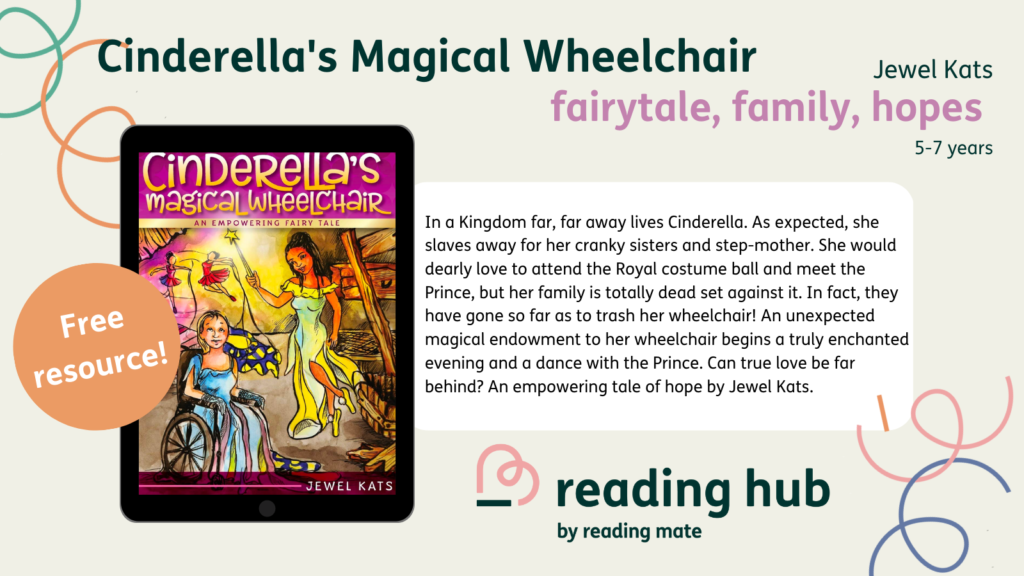Teaching learners who have identified special educational needs can be a daunting task. These learners may have difficulty with traditional instruction and need more support in order to participate fully in the life of their school. A SEN teacher helps these learners overcome any barriers to learning and make progress. They work with colleagues to ensure that all learners in their class make progress, and may also provide specialist support to individuals or groups of learners.
Looking for resources to support your learners? Check out this activity plan for Jewel Kats’s Cinderella’s Magical Wheelchair.

1. What is SEN teaching and who does it involve
2. What are the challenges of SEN teaching and how can they be overcome
3. What qualifications are needed to become a SEN teacher
4. How to get started in SEN teaching
5. Resources for SEN teachers
6. Book recommendations for SEN
What is SEN teaching and who does it involve?
SEN teaching is a specialised form of instruction that involves the support and guidance of learners who have been identified as having special educational needs. These learners may require more assistance than traditional learners in order to overcome barriers to learning and participate fully in the school setting. An SEN teacher provides this support, working with colleagues to ensure that all learners in their class make progress. They may also provide specialist support to individuals or groups of learners.
What does SEN teaching involve? SEN teaching can be done by anyone who has the required qualifications and training. This includes teachers, teacher assistants, and specialists such as therapists or counsellors. It is important that SEN teachers have a good understanding of the needs of learners with special educational needs and are able to adapt their teaching style to meet these needs.
What are the challenges of SEN teaching and how can they be overcome?
Teaching learners who have identified special educational needs can be a daunting task. These learners may have difficulty with traditional instruction and need more support in order to participate fully in the life of their school. An SEN teacher helps these students overcome any barriers to learning and make progress.
SEN teaching benefits students in a number of ways. First, it helps them overcome any barriers to learning that they may have. This can include difficulties with reading, writing, maths, or social skills. SEN teaching also helps children learn in a way that is best suited to their individual needs. This can make learning easier and more enjoyable for them. SEN teaching can also help learners feel more connected to their school and classmates. This can boost their self-esteem and help them feel more confident in their abilities. Finally, SEN teaching can help learners of all abilities not just those with additional needs.
What qualifications are needed to become a SEN teacher?
To become an SEN teacher, you need to have a qualification in teaching, special education, or a related field. You will also need to have experience working with learners who have special needs. It is important to be patient and understanding when working with these students and to be able to adapt your teaching style to meet their needs.
How to get started in SEN teaching
If you’re looking to start a career in SEN teaching, there are a few things you need to know. First, SEN teaching is an extremely rewarding field and can be very challenging as well. It’s important to be patient and compassionate with your learners and to have the skills necessary to adapt your teaching methods to meet each learner’s individual needs.
Another important thing to keep in mind is that SEN teaching requires a lot of hard work. You’ll need to be familiar with the curriculum and standards and you’ll need to be able to develop lesson plans that meet the needs of your learners. It’s also important to stay up-to-date on the latest research and techniques in SEN teaching, so you can continue providing your learners with the best possible education.
If you’re ready for a challenge, and you have the necessary skills and passion for SEN teaching, then this may be the perfect career for you. There are many ways to get started in this field, so do some research and find the option that best suits your needs. There are undergraduate and graduate programs specifically designed for SEN teachers, or you may be able to find certification programs or training workshops. No matter what route you choose, make sure you get plenty of hands-on experience working with learners who have special needs. This will be essential in helping you develop the skills you need to succeed as a SEN teacher.
Resources for SEN teachers
There are a number of resources available for SEN teachers. The best place to start is with the Department of Education, which will likely have information on SEN teaching programs and resources. You can also find helpful information online, including websites and forums specifically for SEN teachers.
Another great resource is your local school district. Many districts have SEN support programs, which may include special education classes, training workshops, and more. Talk to your supervisor or administrator to learn more about these programs and how to access them.
Finally, don’t forget to connect with other SEN teachers. There are many online communities and forums where you can share ideas, ask questions, and learn from others who are experienced in SEN teaching. These connections can be invaluable in helping you develop as a SEN teacher.
Book recommendations for SEN teaching
Books welcome readers from every background, so we must ensure books are plentiful for SEN teaching. While some learners may not ‘read’ in the traditional sense, they can get a huge amount from enjoying pages filled with engaging images (if you’re concerned your learners may have difficulties reading, check out this blog). To support your SEN learners with reading, ensure the stories are simple, there’s a sensory element and (where possible) choose ones with rhyme and repetition.
Some of these stories make excellent sensory stories too where you can bring elements of them to life. You can find many more stories like this in Reading Hub.
This is by no means an exclusive list but it’s a good starter pack.
- That’s not my… by Fiona Watt. Lots of opportunities for sensory exploration and there’s quite literally one for every occasion and taste.
- Perfectly Norman by Tom Percival. Norman had always been perfectly normal . . . until the day he grew a pair of wings!
- Busy Day: Astronaut by Dan Green – 3, 2, 1 . . . Lift off! Join in and use the flaps to help the busy astronaut put on her spacesuit, launch the rocket and drive the moon buggy.
- Ladybird London: Search and Find by Klara Hawkins. Learners can enjoy spotting all the different things you can find in London along with some astonishing facts.
- Peppa Pig: First Phonics. Many of these board books are excellent as the characters are familiar and the stories are simple.
- Little World: Under the Sea by Allison Black. Curious minds can explore the ocean’s depths with this push-and-pull book.
- Magic Windows: Weather by Libby Burns. Whatever the weather, your learners will love this interactive pull-the-tabs book.
- Beautiful OOPS by Barney Salzberg. Every mistake can lead to a beautiful new adventure. An inspiring board book full of pop-ups and pull-the-flaps.
- Stickyscapes at the Museum by Laura Junger. An interactive sticker book: One side of the scene shows a busy museum during the daytime, with enormous dinosaur skeletons, priceless vases, and bored security guards. The other side shows the museum at night – when everything comes to life.
- We’re Going on a Bear Hunt by Michael Rosen. One of my learners’ favourites! Lots of opportunities to join in and use props/sensory materials for the ‘Splish, Splash’.
- Don’t Put Your Finger In The Jelly, Nelly by Nick Sharratt. The combination of humorous rhymes and bright illustrations is great for engagement.
- Dear Zoo by Rod Campbell. Interactive flaps make for great exploration and practice of fine-motor skills.
- The Gruffalo by Julia Donaldson. A classic and much-loved story as well as a lovely opportunity to dress up and role-play.
- The Hospital Dog by Julia Donaldson. A lovely story that many SEND learners can empathise with and enjoy.
- What happened to you? By James Catchpole. Addresses how children with disabilities may be spoken to and how it may feel. A groundbreaking and funny story!
- Me and My Sister by Rose Robbins. An important and sensitive story about sibling understanding of disability.
- Shine by Sarah Asuquo. A celebration of diversity in this heart-warming story about Kai who appears ‘normal’ but wants to share the things that make him different.
- The Gigantic Turnip by Aleksei Tolstoy. A great opportunity to get learners active and explore their senses with this classic tale.
How to support your SEN learners
As an SEN teacher, it is your job to ensure that all learners in your class make progress. This may involve finding creative and adaptive ways to approach teaching depending on the individual needs of each student. Here are some tips for providing the best possible sen teaching experience:
- Understand your learners’ needs – Before you begin SEN teaching, it’s important to develop an understanding of your learners’ specific needs. Get to know them as individuals and explore their interests, strengths, and weaknesses. This will help you create SEN teaching materials that are tailored to their unique learning style.
- Create a safe and supportive environment – An SEN classroom should be a safe and supportive place where learners can feel secure. Make sure to set clear boundaries and expectations, while also providing opportunities for students to express themselves freely.
- Incorporate play-based learning – Play-based learning is an important part of sen teaching as it helps children develop the skills they need to succeed in school and life. Incorporate activities such as arts and crafts, music, games and storytelling into your sen teaching to give learners the opportunity to learn in a fun and engaging way.
- Encourage independence – SEN learners often need more support than other learners, but you should also encourage them to become independent when possible. Provide tasks that promote problem solving and critical thinking, as well as activities that help learners become more self-reliant.
- Be patient – The SEN teaching experience can be challenging for both you and your learners, so make sure to stay patient and keep an open mind when working with learners who have special educational needs. Take the time to explain things in a way that makes sense and be willing to adjust your sen teaching approach if something isn’t working.
These tips can help you create a successful SEN teaching experience for both you and your learners. With patience and understanding, you can provide the support that learners with special educational needs need in order to thrive in school and beyond.
To make reading a habit for children with SEN, check out this article by our very own, Hannah Rix.
Conclusion
An SEN teacher helps these learners to overcome any barriers to learning and participate as fully as possible in the life of their school. They work with colleagues to ensure that all learners in their class make progress, and may also provide specialist support to individuals or groups of learners. Challenges of SEN teaching can be overcome by using adaptive teaching methods which help students learn in a way that best suits them. Benefits of SEN teaching include individualized attention, increased academic success, and improved social skills for all learners.
For more tips on supporting your different cohorts, check out these resources.
Would you like to support your SEN learners with these books and more? Find them on Reading Hub!
Related articles:


